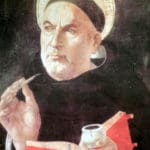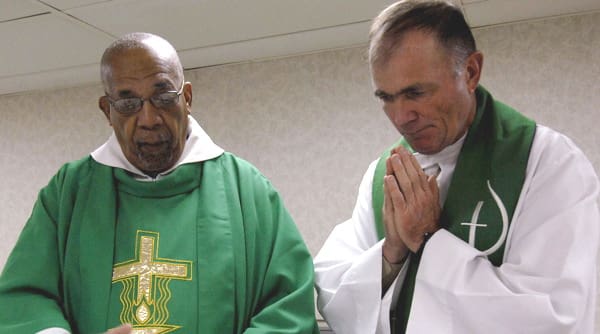The Central Prayers of the Mass:
We can pray the Mass better if we better understand its central prayers. Knowing what is going on allows us to join in and make the prayer our own – allows us to mean it when we say, “Amen.” It also allows us to understand the Mass itself, and so enter more deeply into what it has to offer us. Today we will consider the priest’s part of the Eucharistic Prayer. The “Eucharistic Prayer” itself consists of two parts:
- The Preface, which I wrote about in my previous post, beginning with “Lift up your hearts” and ending with “Holy, Holy, Holy” (with a sung prayer in between that people can hear) can be called the people’s half of the Eucharistic Prayer.
- The Anaphora, then, is a Greek word for the part where the people (after the “Holy, Holy, Holy” or “Sanctus”) kneel for what can be called the priest’s half. Today we are examining the priest’s prayer.
History: In the Roman Rite, a standard prayer evolved over the centuries that was always used by everyone. Since the Preface (the people’s part) varied from Mass to Mass, the priest’s part came to be known simply as “the canon” meaning “the rule” (the way it had to be done). And, this was the case for several centuries.
 Theology: Theologians like St. Thomas Aquinas have noted that, properly, the only words that cannot change are Jesus’ own words, “This is my Body” and “This is my Blood.” Everything else has been added by the Church to help us enter into these words. And indeed, in the Christian East, the priest’s prayers that surround these words have always differed, and indeed, differed from day to day, with the only “canonical” part being the great words of Jesus Himself.
Theology: Theologians like St. Thomas Aquinas have noted that, properly, the only words that cannot change are Jesus’ own words, “This is my Body” and “This is my Blood.” Everything else has been added by the Church to help us enter into these words. And indeed, in the Christian East, the priest’s prayers that surround these words have always differed, and indeed, differed from day to day, with the only “canonical” part being the great words of Jesus Himself.
Eucharistic Prayers: To reflect that the essential words are those central words of Jesus–and, not the rest of the “canon,” the liturgical reform after Vatican II multiplied what are now called “Eucharistic Prayers.” “Eucharistic Prayer I” is the old Roman canon, fabulously rich in theology and tradition. The main ones they added are “Eucharistic Prayers II-IV.” The reformers were clear about the rationale: they wanted all of these prayers to include the same elements, but to provide longer and shorter options.You are probably most familiar with “Eucharistic Prayer II,” the short one, which you can recognize early on by “the fount of all holiness” and “send down your Spirit like the dewfall”; and “Eucharistic Prayer III,” the medium-length one, which you can recognize by “from the rising of the sun to its setting.” Since Eucharistic Prayer IV is just as long as Eucharistic Prayer I, but without the tradition, most priests rarely use it.
+++
Parts of the Anaphora:
All of these “anaphoras” (or Eucharistic Prayers I, II, III or IV) are composed of two kinds of prayers: the central parts of the Eucharistic prayers, and the prayers for fruits that we ask to obtain from the Eucharist.
The four central parts of the Eucharistic prayers:
The first two parts make Jesus present:
The epiclesis, “invocation” or “calling down upon” calls on the Holy Spirit. We ask God to make the bread and wine “spiritual and acceptable, so that it may become the Body and Blood.” Jesus and the Holy Spirit are inseparably united: we receive the Holy Spirit by receiving Jesus, but to make Jesus present, we call on the Holy Spirit.
- Then follows the “Institution Narrative,” in which the priest quotes the words of Jesus. Essentially, Jesus becomes present because he said he would. It is interesting to notice that the priest is quoting. The prayer is actually addressed to the Father (not to us), with Jesus in the third person: “he took bread in his holy and venerable hands, and with eyes raised to heaven, to you, O God, his almighty Father . . . saying, ‘Take this.’” The priest’s authority is not to “become Jesus,” but to quote Jesus to the Father and know that the Holy Spirit will make Jesus’ words come true.
Then, there are two prayers about what we do with the Eucharist:
- Immediately following the “mystery of faith” comes the anamnesis, or memorial prayer. “As we celebrate the memorial,” it says, just after having quoted Jesus saying, “do this in memory of me.” One function of the Eucharist is to make present now what happened long ago. We call to mind Jesus’ actions, at the Last Supper and on the Cross, and the Holy Spirit makes them present on the altar now. History collapses, and we are united to Good Friday, the very center of history.
The second prayer of what we do with the Eucharist is the final doxology, or giving glory: “through him, with him, and in him, in the unity of the Holy Spirit, all glory and honor is yours almighty Father.” The Eucharist is properly an act of worship. The Holy Spirit brings us into union with Jesus’ perfect worship of the Father.
Prayers for fruits that we ask to obtain from the Eucharist:
Surrounding these prayers, and interlaced with them, are prayers for the fruits of the Mass. Interestingly, they are all prayers for the Church, in her various members. We pray for the leadership of the Church, for all the living members of the Church, for whom we ask (above all) union with the Church, and for the dead, that they may join the Church in heaven. And, we invoke our communion with the Church in heaven, by naming some (or, in the Roman Canon–Eucharistic Prayer I–many) saints. These prayers remind us that the Eucharist makes the Church. It is in this communion, with God, with one another, and in perfect worship, that we receive God’s greatest blessings.
Indeed, the Roman Canon adds several “acceptance” prayers, which tie the prayers for fruits more closely to the central prayers of the Eucharist. We pray that we may offer true worship like Abel, Abraham, and Melchizedek did. And, we pray that we may pray in union with the “altar in heaven”: the truest worship, above. “Accept these offerings,” we pray, for the good of “your holy Catholic Church.” “Accept this oblation” so that we may be “counted among the flock of those you have chosen.”
Editor’s Note: We thank Dr. Johnston for this brief explanation of the anaphora. We hope it will help all of us pray the Mass better and better understand its central prayers, allowing us to enter more deeply into the Eucharistic mystery.
+
Art for this post on the anaphora: Thomas von Aquin, unknown date, Sandro Botticelli, PD-US; Holy Spirit Detail from “Chair of Saint Peter in St. Peter’s Basilica”, 03 05 2008, Sergey Smirnov, CCA-SA; “Chaplain Lt. John Burnette prays over the Blood and Body of Christ during Sunday Roman Catholic Mass aboard the Nimitz-class aircraft carrier USS Harry S. Truman”, 24 October 2004 (Atlantic Ocean), U.S. Photographer’s Mate Kathaleen A. Knowles, PD; all Wikimedia Commons. Feature Image: PORT-OF-SPAIN, Trinidad and Tobago (Sept. 21, 2007) – Father Joseph Harris, left, a Roman Catholic priest in Trinidad and Tobago, celebrates mass with Lt. Cmdr. Paul Evers, a Navy chaplain and Roman Catholic priest, aboard Military Sealift Command hospital ship USNS Comfort (T-AH 20), U.S. Navy photo taken by Mass Communication Specialist 2nd Class Joan E. Kretschmer, 21 September 2007, PD-US work of the U.S. federal government, Wikimedia Commons.



